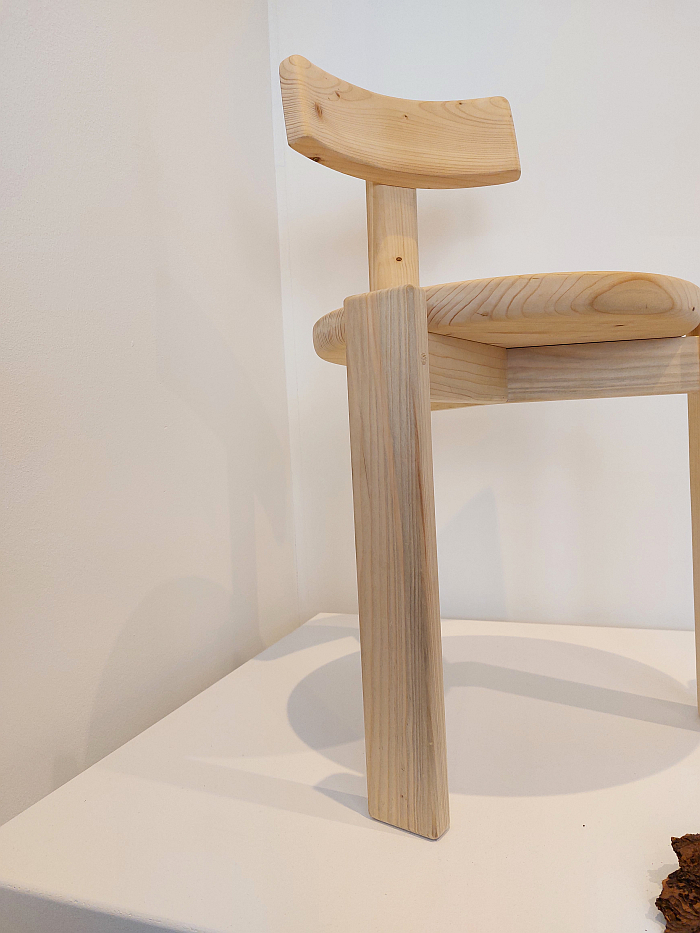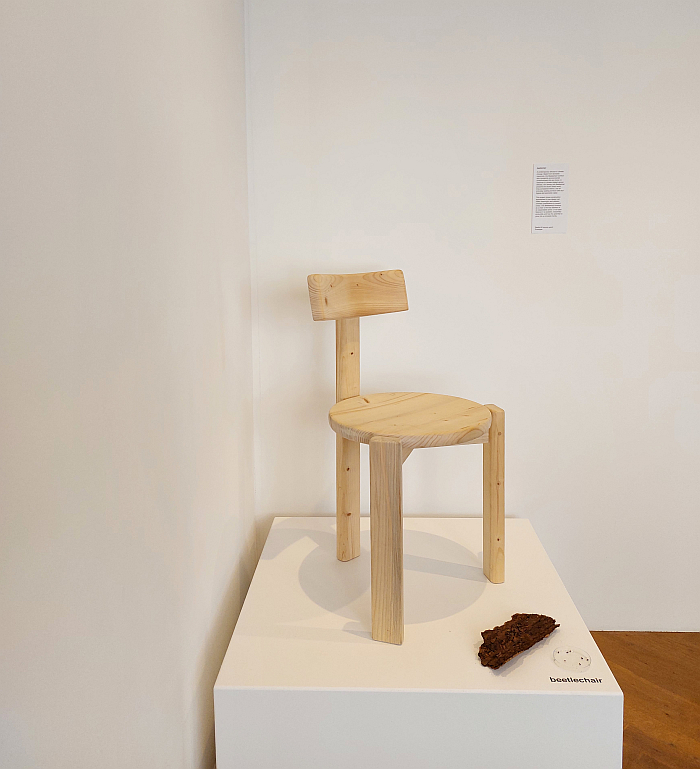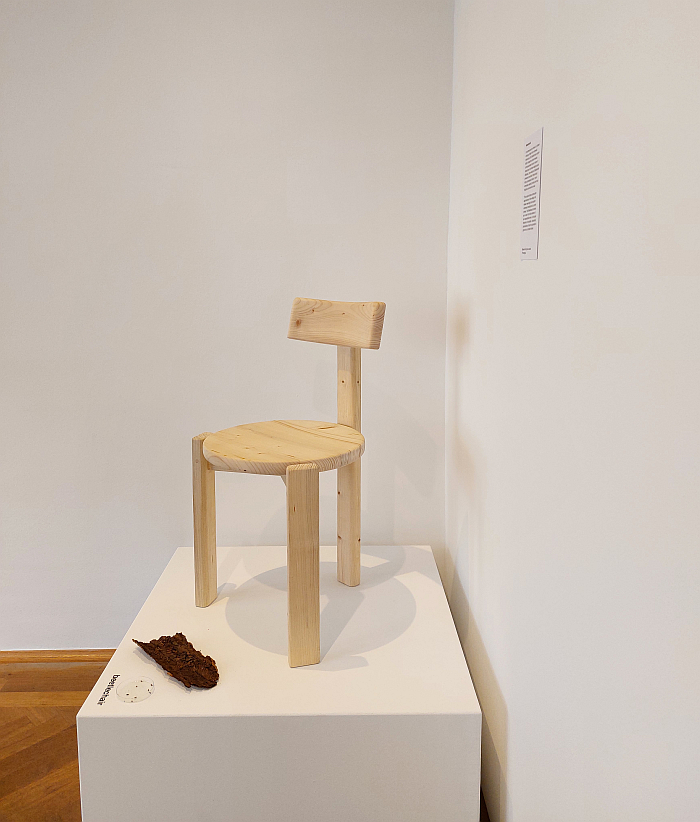Passagen Interior Design Week Cologne 2024: Beetlechair by Alexander von Dombois
There is an argument to be made, indeed one we will make here without offering any evidence, we’ll save that for another day, there is an argument to be made that some of the earliest forbearers, if not the earliest forbearers, of our contemporary side chairs were three legged: the three-legged stool is an object known across time and geography and class, and there is a particularly satisfying, particularly elegant, proposed narrative of furniture (hi)story in which some long since forgotten carpenter decided to extend one of the legs of his three-legged stool and to attach a rudimentary back support. Either as a response to the novel four-legged back-stools of the 17th century, or as a precursor of the 17th century four-legged back-stool, the latter for reasons equally long since forgotten.
What is much less debatable is that since it’s arrival the three-legged chair has firmly established itself as a chair typus, and that across materials, positions and contexts. And that not least because three-legged chairs are inherently stabler than four-legged chairs. And simpler to stack. And neatly contrast with the quadraticness of the built environment, without challenging the primacy of that quadraticness. Implies an alternative while supporting the status quo.
And thus today a three-legged chair is, as with its four-legged and cantilevered cousins, rarely that interesting, or at least rarely interesting outwith considerations on the (hi)story of furniture design.
A three-legged chair can however be interesting. Occasionally very interesting.
When its three-leggedness isn’t its principle characteristic. Isn’t its raison d’etre.
Such as the case with the Beetlechair by Cologne based designer Alexander von Dombois.
Whereby, yes, beetles do normally have three pairs of legs. Rather than three legs.
Ants, in contrast, do have three legs. At least in an Arne Jacobsen’s understandings of Ants. In Fritz Hansen’s understandings Ants have four legs. But that’s a debate for another day. Ants aren’t Beetles.
And in any case beetles per se aren’t the subject at hand, rather the bark beetle is, specifically, primarily, Ips typographus, the European spruce bark beetle, a beetle that for all it is an important component of the forest ecosystem, not least in context of the decomposition of dead wood, is also an important causal agent of Spruce Dieback, a condition that is increasingly ravaging, devastating, the forests of Europe. And which will, in all probability, increasingly do so as climate change not only increasingly impacts upon, hinders, stops, spruces’ natural defence mechanisms against Ips typographus and its ilk, and thereby increasingly making spruce increasingly susceptible to even the mildest infestation, but also enables Ips typographus to populate previously inhospitable regions, and altitudes, and thereby ravage, devastate, ever greater areas. An increasing spread and ravaging and devastation that is also a consequence of the prevalence, arrogance, of commercial monoculture forestry in contemporary Europe. And an Ips typographus that also reminds that while typographers can be useful, they should always be treated with caution.
In addition to the physical damage Ips typographus directly causes it also transports members of the Ophiostoma fungus order into spruce, a fungi which not only negatively impacts on the trees ability to defend itself from Ips typographus and other aggressors, but also stains, dyes, the wood blue.
Now, if like us the following piece of information is new, hold on to your hats, they may blow off….
…. a blue colouration that significantly reduces the value of the wood: both the commercial, financial, value of the wood, with the consequences that has for the forestry industry, and the ‘acceptance’ value, means it is rejected and dismissed for all and any use where the blue stain would be visible. And definitely isn’t used for furniture or interior fittings.
No! Honest!
And that despite, as best we can ascertain, neither the Ophiostoma nor Ips typographus adversely affecting the structural quality of the wood: Ophiostoma/Ips typographus infested wood isn’t structurally inferior to uninfested wood. It just has a blue hue. On which basis alone it is rejected, dismissed, devalued by the furniture industry.
No! Honest!
Alexander von Dombois, very sagely in our opinion, isn’t in agreement with the contemporary reality, and so employed popularly denounced blue spruce in a chair.

…the blue discolouration isn’t that pronounced in Alexander von Dombois’ Beetlechair, which tends to further underscore the absurdity of its rejection by the furniture industry.
A chair based around a very straightforward, rational, construction principle, as are beetles; a construction principle which although interesting, isn’t a primary concern at this juncture.
A chair whose use of material is not only efficient but also conceived with the aim of improving production efficiency; a use of material which although interesting, isn’t a primary concern at this juncture.
A chair with an open, inviting, formal expression, a work which is communicative and approachable and which we can well imagine, we only saw a single copy in a showroom space, but can well imagine, can and will stand self-confidently in any room without dominating it, without seeking to dominate; a formal expression which although interesting, isn’t a primary concern at this juncture.
A chair which isn’t conceived as a chair but as the start of a wider furniture programme based on extrapolations and scalings of the construction principle and use of materials and formal expression; a future furniture family which although interesting, isn’t a primary concern at this juncture.
A chair we forgot to sit on. Genuinely, we know, outrageous, however our thoughts were quite simply so far outwith the exhibition space, in far off realms, that it didn’t occur to us actually test the sitting comfort and security. Not that we see any pressing reasons to question such, everything else says such will be fine. And in any case the sitting comfort and security isn’t a primary concern at this juncture.
At this juncture the primary concern is the discourse Beetlechair enables, stimulates and demands on our relationships with wood, our relationships with materials, and for all the relationships on and with the materials, the wood, we use for furniture and in our interior spaces in general. The questions it stimulates and demands we pose on our insistence that the wood used in our furniture be as flawless as the construction, on our preconceptions regarding the appearance of the wood in our wooden furniture, on our culturally conditioned classification of wood as being ‘suitable’, ‘good’, ‘correct’. Or not.
A discourse also demanded, for example, by Matthias Gschwendtner in his project New Sources as seen at Grassimesse 2023 which employs AI and contemporary digital production technology to produce chairs from the branches and other pieces of ‘waste’ wood that are routinely ignored by the furniture industry and sent off by the forestry industry to be shredded and burnt.
A discourse also demanded, for example, by Branchwood by Jakob Niemann as seen in the showcase The Series during Vienna Design Week 2023, which employs branches to produce furniture inspired by Thonet bentwood furniture, albeit furniture which rather than expressing itself with the smooth, straightened, standardised, knot-free character of Thonet’s pre-industrial industrial production process, is proudly awash with knots and knobbles and inconsistencies and variation.
A discourse also demanded, in many regards, by the various discussion of late in these dispatches on gardens, for all those discussions on gardens as nature, but under human control; of us all wanting gardens to look natural, but then strictly defining what ‘natural’ is based on our preconceptions and seeking to achieve that through controlling, limiting, harassing nature. Similarly our furniture, or more accurately our contemporary interiors, should be ‘natural’, should be reflective of a contemporary appreciation that human society is a component of the environment in which it exists, of us as one with the natural world, should have lots of fabric and plants and light and colour and wood…….
…….but not wood stained blue by Ophiostoma!!! No, No That’s repugnant. Ick. That’s not natural. Except it is. Very. It’s forest life in action. The daily battle for survival in the forest that is also a battle of the urbanite.
Or put another way, we don’t want the forest to be present in our furniture and interiors, we want wood, we want ‘wood’.
We’ll happily stain wood blue, but don’t want blue stained wood.
We want a patina to develop on our wood, but don’t want blue stained wood.
We’re a funny old species
And is, in many regards, also a discourse inherent in the opinion of Dieter Amick from Rowac in context of the difference between the Rowac stool which shows its construction, presents its workings to the user, as does Beetlechair, and that very elegantly and matter-of-factly, and the smooth perfection of Danish wooden furniture; furniture that not only hides its joints and workings behind a post-production as diligently undertaking as that in commercial photography, but which since the 1950s has been heavily marketed on the basis of the flawlessness of the materials and construction, on a possessing of a quality and value arising not only from an ages old handcraft tradition, but from ‘perfect’ wood. Imagine a manufacturer presenting the works of a Hans J Wegner, a Børge Mogensen, a Peter Hvidt, a Orla Mølgaard-Nielsen, a Kaare Klint, a whoever, in wood that was anything other than flawless, in wood that in any sense failed to live up to popular conceptions of ‘flawless’, wood that wasn’t ‘suitable’, ‘good’, ‘correct’. In wood stained blue by Ophiostomatoids.
OK, yes, admittedly the above named didn’t work that much in spruce, rather teak and similar hardwoods were more their things, but the arguments Beetlechair makes, the discourse it demands, isn’t and aren’t limited to spruce, Ophiostomatoids and Ips typographus, rather is and are much much wider. Blue spruce is but the conduit.
And a very satisfying one.
Not least because on the one hand while the furniture industry is very happy to adorn itself with certificates extolling how sustainable and responsible and environmentally friendly its wood is, it happily rejects vast quantities of perfectly usable wood simply because of a blue colouration, and you’re clearly not sustainable if your prejudiced. And on the other hand because of the direct associations with climate change and commercial monoculture forestry, associations which highlight consumerism, overconsumption, as causal factors in both and thus that solving the problems of climate change and commercial monoculture forestry, problems we’ve created, can only come through us changing our behaviour. All the AI in the world won’t solve the problems caused by us rejecting wood because its stained blue, while demanding ever more wood. Ever more ‘wood’.
And while, yes, for all that Beetlechair and its underscoring of its use of spruce stained blue by Ophiostomatoids transmitted via Ips typographus does, unquestionably, have something of the virtue signalling of the white, heterosexual, non-disabled, CIS male owner of a business telling anyone and everyone that they employ non-white, non-heterosexual, non-non-disabled, non-binary individuals, about it, it is, we’d argue also important, very important at this stage, that it does underscore its blue wood, that it is highlighted. It’s a conversation the needs to be had. But the day must come, ideally quickly, when the use of spruce stained blue, or indeed the use of any wood that deviates from long held culturally conditioned understandings of ‘wood’ isn’t commented on. Isn’t interesting.
Similarly while Artek’s use of ‘wild birch’ i.e birch which doesn’t conform to popular conventions of “flawless”, birch which isn’t the sort of standardised wood demanded by the contemporary furniture industry, birch which isn’t conventionally considered ‘suitable’, ‘good’, ‘correct’, is without question a very positive step, and as with Beetlechair, New Sources, Branchwood, et al an important contribution to an urgently needed discourse on not only the wood we use for furniture but our relationships to wood, trees, forestry and the environment, as long as ‘wild birch’ is only used for a variant of Stool 60 one can validly question why? Why not employ it as the standard wood across the Artek portfolio? Why not?
And while there is an argument to be made, one we would and do make, that Artek should do that, should make that wholesale step, there is also a very convincing argument that if consumers won’t buy furniture made from knotted, squint, holed, stained wood, why produce that furniture in a commercial context? Why produce the furniture of a Hans J Wegner, a Børge Mogensen, a Peter Hvidt, a Orla Mølgaard-Nielsen, a Kaare Klint, an Alvar Aalto, an Aino Aalto in anything other than flawless ‘wood’, if only flawless ‘wood’ will sell? So start somewhere, Stool 60 is a good place, and then move forward. Whereby we’d still prefer Artek to move en masse to ‘wild birch’ today.
Arguments that help elucidate that for all the move to ‘wild birch’ is one for Artek to make, in many regards Artek, and all other furniture manufacturers, need us to force their hand: as long as we all demand flawless ‘wood’ in our furniture, as long as we all demand ‘wood’ that denies it has anything to do with trees, as long as we all demand ‘wood’ that conforms to our culturally conditioned definitions of ‘suitable’, ‘good’, ‘correct’, we’ll not buy ‘wild birch’ furniture, we’ll not buy Wegner chairs with knot holes, we’ll not buy blue stained spruce. Thus while change unquestionably demands a change of attitude in the furniture industry it primarily demands, is primarily dependent upon, us all accepting wood that deviates from our long held, culturally conditioned conventions of what is ‘suitable’, ‘good’, ‘correct’. Our long held, culturally conditioned conventions on furniture ‘wood’.
That day can come, cultural conventions can and do change over time, views can change; we all once assumed the white, heterosexual, non-disabled, CIS male to have a natural primacy in society, and while many still believe that to be true, the greater majority know its not, and are seeking ways to deconstruct that which was done in its name, and the damage it caused. And lest we forget there are strong connections between furniture and society.
And when that day comes, when we stop obsessing about ‘perfection’ in our wood, we can all focus on Beetlechair’s construction principle, use of material, formal expression, family, sitting comfort, sitting security and place in the (hi)story of three-legged chairs, for those factors are interesting and well worth engaging with. Which, yes, is also a metaphor.
Until then it’s important that Beetlechair is also Ophiostomachair. A chair less for sitting on, as for learning from.
And a chair looking for a producer. If any are out there who want to contribute to helping us all develop more sustainable and responsible definitions of wood for furniture, and to much more sustainable and responsible forestry, a much more sustainable and responsible furniture industry, and who’re keen to add a charming wooden three-legged chair, and its immediate family, to their portfolio, you know what to do.
Passagen Interior Design Week Cologne 2024 has now ended. But more information on Beetlechair and Alexander von Dombois can be found at https://alexandervondombois.de
Tagged with: Alexander von Dombois, Beetlechair, cologne, Ips typographus, köln, Ophiostoma, Passagen, Passagen Cologne, Seating

